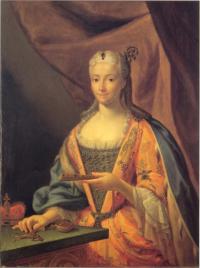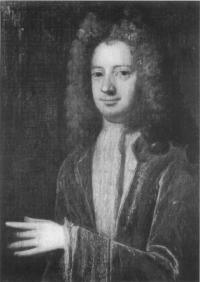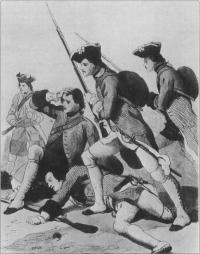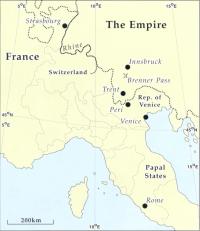Making a Hole in the Moon: the rescue of Princess Clementina by Tony Canavan
Published in 18th–19th - Century History, Features, Issue 4 (Winter 1993), Volume 1
Priness Clementina Sobieska by unknown artist. (COURTESY OF THE SCOTTISH NATIONAL PORTRAIT GALLERY)
On a cold April morning in 1719 a carriage containing an Irish lady and her maid, escorted by her husband and four companions, left the fortress city of Strasbourg to cross the Rhine. As they departed the governor of the city spoke to them, ‘Adieu mes enfants, you are not crossing the Rhine for nothing, and you seem to be engaging in an attempt to make a hole in the moon. May God guide you, for I know you are men who will conquer or die’.

Sir Charles Wogan by unknown artist.
(COURTESY OF THE NATIONAL GALLERY OF IRELAND)
Escape plan
Cooked chickens
Wogan had set 27 April as the day for the escape and went ahead making preparations for this date. He even bought and cooked some chickens for the journey – doing the cooking himself so as to keep his intentions secret from the innkeeper. The earlier unforeseen arrival at Innsbruck of the Prince of Baden threatened the success of the escape plan as he was an ardent suitor (for the £100,000 at least!) and called on the princess every day. He would be quick to raise the alarm if he suspected something. A message was sent to Wogan to delay until the troublesome prince could be got rid of. It was not until the 27th itself that Baden finally got the message that Clemen tina was not interested in him and left. The escape could now proceed. Wogan’s plan was simple. Clementina would retire to her bedroom feigning illness and refuse to see all visitors, especially her gaoler, General Hester. That night Wogan would sneak Madame Missel’s maid Jeanetton, inside and the two wome~ would swap clothes enabling the princess to leave the house in the guise of the maid. She would then travel with Wogan and his companions to Rome. On the 28th Clementina retired to her room and the rescue party moved to an inn, the Black Eagle, on the outskirts of Innsbruck. By this time a terrible storm had blown up, one of the last of winter, and it looked as if the escape would have to be called off. Although her mother forbade the attempt in such appalling weather, Clementina was determined to go through with it. Wogan too had decided to go ahead as planned, come what may. He had already risked enough staying so long in imperial territory and so he was much relieved to receive word that the princess was as determined as himself.

Members of the Irish Brigade in more conventional action. ( Print by Ernest Meyer, Paris 7750)
High heels
One flaw in Wogan’s plan was that he had not informed Jeanetton of her part. On the afternoon of the 28th when Wogan told her that she would have to remain in the house in Innsbruck while O’Toole escaped with his fiancee·;- it was thought safer to tell her that the escape was for OToole’s benefit so that he could marry a lady despite her parents’ wishes – she agreed until told that the lady in question was,quite small and that therefore Jeanetton would have to wear flat shoes. Jeanetton was a tall woman and proud of her height, which she even exaggerated by wearing high heels. At this pOint she refused outright. It looked as though the fate of the Stuart succession was to be blighted for the sake of high heels, and it took a great deal of pleading by O’Toole before she would agree. By half past eleven when Wogan and Jeanetton set out to meet Clementina’s servant, Konska, a blizzard was blowing, and it was with difficulty that he took them through the town to the house. Wogan waited at a nearby corner, sword at the ready, while Konska took the maid off. Minutes passed and there was no sign of the princess coming from the house. Wogan waited and waited but still there was no sign of her. Just as he was deciding whether to give up or to get into the house, two figures emerged through the snow, Clementina and Konska. She had left behind letters to her mother and General Hester accepting full responsibility for the escape and carried with her a bundle containing the Stuart family jewels which had been sent to her previously as part of the marriage arrangements. The trio arrived wet and muddy at the Black Eagle. Clemen tina was in a particularly bad state as she had fallen into a stream on the way. Time was of the essence. As soon as the flustered princess was in dry clothes, they woke their drivers, got the coach ready and took off on the road to the Brenner Pass. They were well on the road and the sun was already up when Clementina realised that she had left the packet of jewels back at the inn. If they were discovered, the game was up. OToole was ordered to ride back as fast as he could to retrieve them and to join the party at the pass. The snow prevented them from going very fast and the drivers had to be promised plenty of ‘drinkgeld’ to continue at all. There was relief at any rate when OToole returned withthe jewels and they proceeded with great difficulty to ascend the pass. At the inn on the summit they met with Misset. While they were changing horses, Clementina fainted and had to be treated by Madame Misset before they could continue. However they soon renewed their journey.

Medal in commemoration of the escape, 1719.
Reckless driving
Their first real difficulty once they got past the snow line was the chickens which Wogan had prepared.These proved to be almost inedible which was not surprising as they had been cooked three or four days before and were only eaten because there was nothing else. These chickens probably account for the bouts of sickness felt during the journey. A more serious danger occurred on the descent along the valley of the River Adige when they met a cart coming in the other direction. The road was very narrow and there was little room to pass. In speeding past the cart, their carriage almost went over the precipice which dropped down to the bottom of the deep valley. Only an old tree trunk sticking out from below the edge of the road saved them. O’Toole, who was riding behind, came alongside and beat the drivers with his whip for their carelessness. When they stopped later to change horses at Brixen, O’Toole’s face still showed such a look of horror at the close shave that Wogan took him aside so as not to alarm the women. At Brixen they got the unwelcome news that the Prince of Baden and his entourage were not far ahead of them on the same road. If all was going to plan, it would be some time before Hester discovered the escape and raised the alarm. Wogan decided to take no chances and near Trent he asked Misset and OToole to remain at a staging post to intercept any messenger that might come that way. That morning a suspicious Hester had forced his way into the princess’s room, killing Konska who resisted, and discovered Jeanetton in her place. Immediately he sent couriers along all the likely escape routes to alert the authorities. One of these did come along the road with a dispatch for the Prince of Taxis, governor of Trentino. Misset and OToole disposed of this courier by inviting him to join their table and then drinking him under it. When the courier eventually collapsed under the influence of wine and brandy, they relieved him of his dispatch.
 Broken axle
Broken axle
Further reading: Dictionary of national biography (London 1900). J.M. Flood, The life of the chevalier Charles Wogan (Dublin 1922). J.C. O’Callaghan, History of the Irish Brigades in the service of France, (Glasgow 1870). J.T. Gilbert (ed.), Narratives of the detention, liberation and marriage of Maria Clemintina Stuart (Dublin 1894).
















